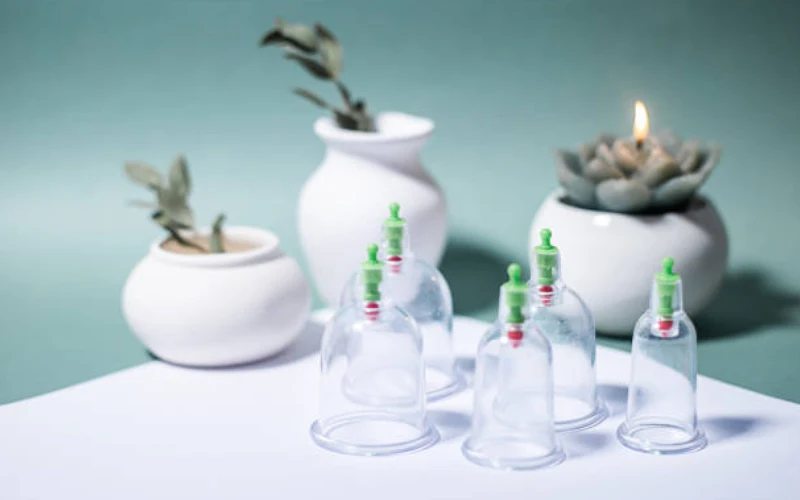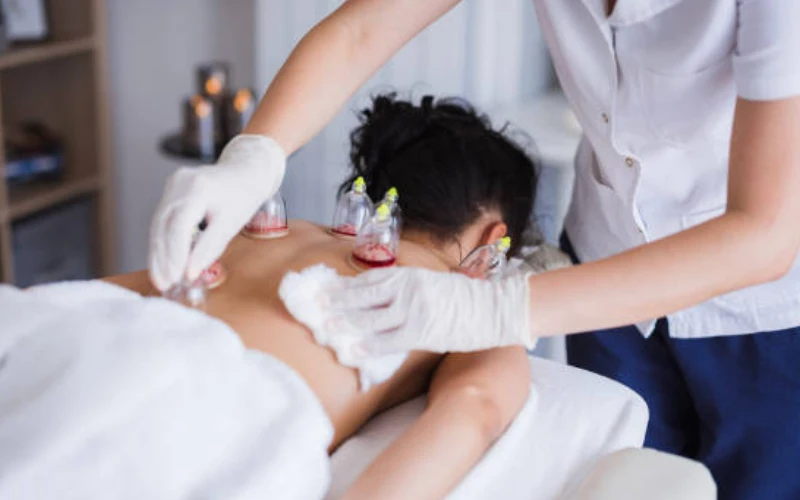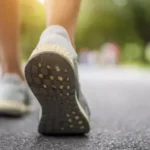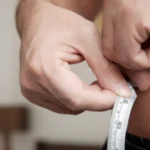For centuries, people across the globe have explored alternative medicine to improve their health and well-being. One such practice that has stood the test of time is Hijama, also known as wet cupping therapy. This ancient procedure involves using vacuum medical cups to remove small amounts of blood from the body, a technique believed to cleanse toxins, promote healing, and restore balance.
But is there any scientific basis behind these claims? And can this centuries-old therapy still benefit us in today’s modern world? Discover the fascinating history, potential health benefits, and risks associated with Hijama in this Lifenday.com article.
What is Hijama?
Hijama (which can be translated from Arabic as “restoring the body to its natural state”) is a traditional medicine technique that uses cups to create a vacuum on the skin to improve blood and lymph circulation. It is often performed in conjunction with bloodletting.
“This is a technique used in alternative medicine to treat various diseases. Many remember it from the Soviet Union as “cupping” or cupping massage. Now this therapy is actively used in Asia, the Middle East, Eastern Europe, and Latin America”.
Brief History of the Procedure
Hijama is an ancient healing method with a long history. It has been used in various cultures for thousands of years.
Initially, procedures similar to modern hijama were used in ancient Egypt and China. In these cultures, it was believed that the use of vacuum and bloodletting could improve blood circulation, get rid of a large number of diseases and cleanse the body. Moreover, Chinese doctors were convinced that such a procedure helps to restore the balance of Qi energy (human vital energy).
Hijama has found wide application in the Islamic tradition – that is why its Arabic name has reached us. The Prophet Muhammad recommended hijama as a method of treating a number of diseases and maintaining general health. The hadiths (ancient Islamic texts) mention that hijama helps with headaches , back pain and other ailments. Islamic medicine actively used hijama, and to this day it remains an important element of a healthy lifestyle in Arab countries.
In the Middle Ages, cupping spread throughout Europe. For example, in England and France, bloodletting and the use of vacuum cups were part of official medical practice.
With the development of scientific medicine, cupping has lost its status as a popular therapeutic method in most countries, but in some countries, especially in the Arab world and Asia, it continues to be used as an adjunct to modern treatment.

Types of Hijama
Hijama therapy is classified into different types based on the techniques, tools, and methods used. Each type is tailored to achieve specific benefits or address particular health conditions. Below is an explanation of the various types of Hijama:
1. Dry cupping
Dry cupping is a procedure that uses special vacuum cups without further damaging the skin or bleeding. In this case, cups are simply placed on certain areas of the body (most often on the back), creating a vacuum.
Operating principle: it is believed that the vacuum in the jars “pulls out” the skin and soft tissues, thereby improving the microcirculation of blood and lymph, relaxing muscles and reducing pain.
2. Wet cupping
Wet cupping involves the same steps as dry cupping, but with an additional step – cuts are made on the skin. After that, cups are placed on small wounds, which create a vacuum, causing the skin to “pull” and so-called bloodletting occurs (by the way, the bloodletting is very small, the blood loss is minimal – you should not imagine this process as, for example, donating blood).
The principle of action: it is believed that through the incisions, “polluted” blood is removed, as well as toxins and waste that may be present in the body, and this supposedly helps to cleanse the body and restore stable well-being.
Thus, dry cupping does not involve bloodletting, but is aimed at improving blood circulation and relieving tension. Wet cupping, on the other hand, involves removing blood, which is supposed to cleanse the body.
Other Types of Hijama
Massage Cupping
Massage cupping blends traditional cupping therapy with massage techniques to enhance relaxation and improve the movement of fluids in the body.
Operating Principle: A small amount of oil is applied to the skin before placing the cups. After creating suction, the cups are gently moved across the skin in smooth, gliding motions. This is believed to relieve muscle tension, improve lymphatic drainage, and enhance skin elasticity.
Fire Cupping
Fire cupping is a more traditional method where heat is used to create suction within the cups, which are then applied to the skin.
Operating Principle: A flame is briefly introduced into the cup to remove oxygen and create a vacuum. The heated cups are immediately placed on the body, causing the skin to be gently pulled into the cups. This method is believed to stimulate blood flow, relieve respiratory conditions like asthma, and reduce muscle stiffness.
Facial Cupping
Facial cupping is a specialized form of cupping therapy designed for the delicate skin on the face. It is often used for cosmetic purposes and sinus relief.
Operating Principle: Small, soft cups are applied with light suction to the facial skin. The cups may either remain stationary or be moved gently in a circular motion. This method increases blood flow, promotes collagen production, reduces puffiness, and enhances skin tone.

Recovery After Cupping
The recovery process after cupping requires care and adherence to certain recommendations in order to achieve maximum therapeutic effect.
- First of all, it is important to remember that bruises may appear in the first hours after the procedure, which are a normal reaction of the body to injury of small capillaries. They will disappear within a few days. To speed up the recovery process, it is recommended to avoid excessive physical activity and sudden temperature fluctuations – do not visit a sauna or bathhouse in the next two days.
- The skin in the areas where the cupping is performed may remain sensitive, so do not expose it to strong mechanical impact or use aggressive cosmetics. In addition, it is recommended to wear loose, non-compressive clothing so as not to injure the areas of impact.
- It is important to maintain water balance. It is recommended to drink more water and avoid alcohol, caffeine and fatty foods during the first 24 hours. This will help the body to restore its normal state faster.
- Some people may feel slightly tired or dizzy on the first day after cupping, which is also normal. In such cases, it is important to avoid overexertion.
After the procedure, it is necessary to very carefully monitor your general health and if any unusual symptoms occur, such as severe pain, redness or swelling in the areas where the cupping was performed, contact a specialist.
When is Hijama Used?
Hijama (cupping therapy) is widely practiced as an alternative or complementary treatment for various health conditions. It is rooted in ancient medicine and is believed to promote healing, detoxification, and overall well-being. Below are the key circumstances and conditions when Hijama is commonly used:
Dry Cupping
Dry cupping is often used for:
- Back pain;
- Muscle clamps;
- Headaches;
- Microcirculation disorders, blood stagnation in certain parts of the body;
- Problems with lymph drainage and swelling;
- Stress and fatigue.
It is believed that in these cases, one procedure is sometimes enough to improve the condition.
Wet Cupping
Wet cupping is used for more serious illnesses, such as:
- Chronic inflammation, in particular inflammation of the upper respiratory tract;
- Joint diseases;
- Dysfunction of internal organs;
- Skin problems (acne, eczema, psoriasis);
- Gastrointestinal diseases.
The procedure is also carried out to improve the general condition of the body, as well as to increase immunity. Sometimes, for the stability of the effect, practitioners advise repeating several sessions of bloodletting.

Contraindications to Cupping
While Hijama (cupping therapy) is considered a safe and beneficial practice for many, there are certain situations and conditions where it may not be suitable. These are known as contraindications to cupping. Below are the key conditions and circumstances in which cupping therapy should be avoided or performed with caution:
Acute Infectious Diseases
- Flu, colds, sore throat – in case of acute viral or bacterial infections, cupping is not performed, since the body is weakened, and the procedure can worsen the condition.
- Purulent inflammations – the presence of purulent viral foci on the skin – are also a serious contraindication, since the procedure can lead to the spread of infection.
Blood Diseases
- Hemophilia and other diseases associated with blood clotting disorders – Hijama can cause excessive bleeding due to disruption of the coagulation mechanism.
- Anemia (especially in severe forms) – the procedure can further reduce the hemoglobin level and worsen the patient’s condition.
Oncological Diseases
In case of cancer (especially in the progression stage), cupping should not be performed, as it can accelerate tumor growth or affect the spread of metastases.
Specific Skin Problems
- Open wounds, ulcers at the site of action – Hijama is not performed on damaged areas of the skin, as this can lead to complications or infection.
- Skin infections – Cupping should also not be done on inflamed or infected areas of the skin.
Pregnancy
- In the first trimester of pregnancy, cupping is contraindicated, as it may affect the development of the fetus.
- There is also a risk in the second and third trimesters, especially if there is a threat of premature birth, problems with blood circulation, or increased uterine tone.
Cardiovascular Diseases
- Hypertension (especially in the crisis stage) – Hijama can cause a sharp change in blood pressure, which in this case can be dangerous.
- Myocardial infarction, stroke, peripheral arterial disease – all these diseases increase the risk of complications associated with circulatory disorders.
Thrombophlebitis and Varicose Veins
Hijama should not be performed on areas where there are varicose veins or blood clots. It can aggravate the disease, cause thrombus formation or rupture of the vessel.
Diseases of the nervous system
- Epilepsy – performing cupping may cause severe tension and stress, which may trigger an attack.
- Acute neurological disorders such as stroke or brain injury are also contraindications.
Mental Illnesses
In the presence of mental illnesses such as schizophrenia, psychosis or severe forms of depression, cupping is not used due to possible disturbances in perception and unexpected reactions of the body.
Recent Surgeries
During the first 2-3 months after surgery (especially on the chest, abdominal or spinal organs), cupping is not performed, as this may lead to the development of complications or disruption of the tissue healing process.
Treatment with Certain Medications
- Anticoagulants (blood thinning medications such as aspirin, heparin, and others) – such medications can increase the risk of bleeding and blood loss, so cupping is not recommended in this case.
Anti-inflammatory drugs, immunosuppressants and other agents that suppress the immune system can reduce the effectiveness of cupping and cause side effects.
Scientific research
Most often, the therapeutic effect of cupping is explained from the point of view of logic: Supposedly, increased blood microcirculation and muscle relaxation by default have a positive effect on the body. This may be true, but there is no scientific evidence of the effectiveness of this procedure yet.
According to the US National Center for Alternative and Complementary Medicine, which monitors clinical trials of alternative treatments, there is no convincing evidence of the effectiveness of cupping therapy. There are very few clinical studies on cupping, and most of them are of poor quality.

One review published in the Journal of Alternative and Complementary Medicine analyzed the results of 14 clinical studies on the use of cupping for a variety of conditions, including musculoskeletal pain, migraines, chronic obstructive pulmonary disease, and other conditions. According to the findings, patients were satisfied with the results of cupping for pain. But more research is needed to obtain more reliable data, as the current results do not provide conclusive evidence.
At the same time, an analysis of studies devoted to the treatment of shingles using vacuum cups and bloodletting showed that these studies contain many errors, as well as a high risk of statistical errors. In this regard, evidence-based medicine does not have enough grounds to claim a positive effect of the method.
Doctor’s Opinion
Maria Polner , dermatologist, allergist-immunologist:
Although many believe that hijama cures almost everything, I agree: there is insufficient data on its effectiveness and safety. Although it is a common procedure.
Literature reviews did find that the effectiveness of cupping therapy is currently poorly documented for most conditions, and that meta-analyses showing its effectiveness for treating chronic pain were based on low-quality studies.
At the same time, side effects of cupping therapy are often described in literature. The most common of them are: burns , scars on the skin, hypopigmentation (loss of natural pigment) of the skin. More serious complications include tissue necrosis (skin and muscles), formation of abscesses. During cupping, which involves contact with blood, under conditions of poor sterilization of cups, infection with infectious diseases is possible - hepatitis B, C, syphilis, HIV .
This method can be used as an addition to the main treatment, but only if the main diagnosis is established, and also in the absence of contraindications and compliance with safety rules: therapy must be carried out by qualified medical personnel, in a medical center, in conditions of compliance with all sterilization rules.
However, in real life, these rules are not always followed, patients do not undergo preliminary examination, hijama is performed by people without medical education in inappropriate conditions, which can lead to tragic consequences, even death.
So my recommendation: if you have any disturbing symptoms, it is recommended to contact a clinic for qualified medical help.
1. Does cupping therapy hurt?
Cupping therapy is generally not painful. During the procedure, you may feel a mild pulling or suction sensation on your skin. If wet cupping is performed, there may be slight discomfort from the small incisions, but this is usually minimal and tolerable. Many people describe the overall experience as relaxing.
2. What are the side effects of cupping therapy?
The most common side effects include:
- Circular marks or bruising where the cups were applied (these usually fade within a few days to two weeks).
- Mild soreness or tenderness in the treated areas.
- Rarely, skin irritation or blistering if the cups are applied too long or with excessive suction.
These effects are typically harmless and temporary. Practitioners take steps to minimize discomfort and ensure safety during the procedure.
3. How long do cupping therapy results last?
The duration of cupping therapy benefits can vary from person to person. Some people may feel immediate relief from pain or tension, while others may notice gradual improvement over days or weeks. For chronic conditions, regular sessions may be recommended to maintain long-term results.
If you decide to do hijama, consult a qualified doctor to make sure that the procedure is suitable for your particular body. Also, choose the specialist carefully – he should have a medical education.





